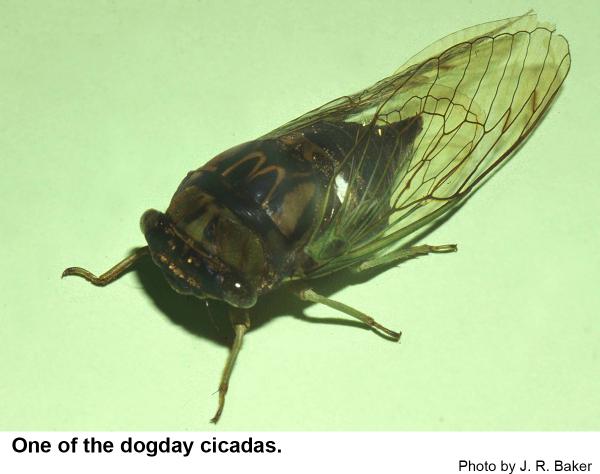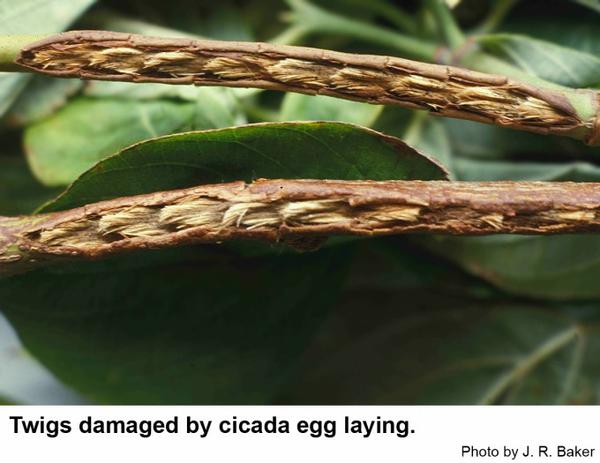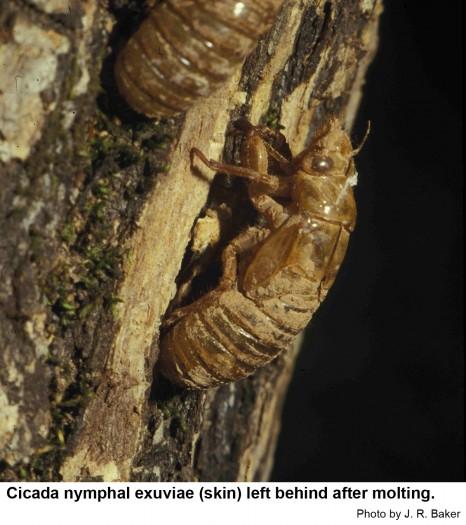Description and Biology
At least 13 species of Neotibicen cicadas occur in North Carolina. "Singing" by male annual cicadas is part of the charm of our summers. Neotibicen cicadas are often called dogday or harvestfly cicadas because the males sing from mid to late summer. The males sing high in trees with long, loud, songs composed of buzzes and clicks. The songs are distinct for each species. We also have one species of the annual Cicada and one species of the annual, petite Cicadetta. Neotibicen cicadas are large, robust, dark insects with light markings and greenish margins on the wings. The females are mute and are attracted to the males' songs. Adults may suck juices from tender twigs. Females jab their eggs into small stems with their saw-like ovipositors. These stems may eventually die and eventually drop to the ground. When the tiny cicada nymphs hatch six or seven weeks later, they fall to the soil, burrow and spend from two up to 10 years feeding on the roots of various plants where they cause no noticeable injury. Cicada nymphs molt four times as they grow. Sometime during each summer, some of the nymphs dig a relatively large hole (sometimes with a mud "chimney" 3 to 4 inches high!) through the soil surface from which they emerge to cling to the bark of trees or other objects while they molt into the adult stage. The papery skins of the nymphs are left behind for children to gather up in and bring inside where they are eventually discarded by mothers that have no appreciation for cicada nymphal skins.
Host Plants
Neotibicen cicadas are associated with deciduous hardwoods (ash, elm, maples, oaks, beeches, persimmon, walnut, and even peach) although some species oviposit in golden rod, sumac, asters, and willow shrubs. Females even oviposit in dead twigs.
Residential Recommendatiosn
Annual cicadas usually occur high in trees and are usually heard rather than seen. Occasionally adults are found at eye level but often fly away quickly when approached. Our trees seem to tolerate feeding by the nymphs on their roots with little noticeable affects on appearance or growth. Because these cicadas are of little consequence to the health of landscape trees, pesticides for their control aren't warranted.
References
- Biogeography of the Cicadas (Hemiptera: Cicadidae) of North America, North of Mexico. Sanborn, A. F. and P. K. Phillips. 2013. Diversity 5: 166-239.
- Common name: cicadas (of Florida); scientific names: Neocicada hieroglyphica (Say), Tibicen, Diceroprocta and Melampsalta spp. (Insecta: Hemiptera: Cicadidae). Walker, T. J. and T. E. Moore. 2004. Featured Creatures. Entomology & Nematology, FDACS/DPI, EDIS.
- Dog-day Cicada IN Field Guide to Texas Insects.Drees, B.M. and J. Jackman. 1999.
- Extension Plant Pathology Publications and Factsheets
- Horticultural Science Publications
- North Carolina Agricultural Chemicals Manual
For assistance with a specific problem, contact your local N.C. Cooperative Extension center
This Factsheet has not been peer reviewed.
Publication date: March 18, 2014
Reviewed/Revised: Aug. 29, 2019
N.C. Cooperative Extension prohibits discrimination and harassment regardless of age, color, disability, family and marital status, gender identity, national origin, political beliefs, race, religion, sex (including pregnancy), sexual orientation and veteran status.




